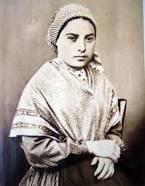
St Bernadette
Feast day: 16 April
Bernadette Soubirous was born in Lourdes on 7 January 1844. She was the eldest of nine children of whom only four survived chilhood. Her father Francois Soubirous was a miller and her mother Louise Casterot was a seamstress. The family had once had a reasonable living but the father was injured and times changed so gradually the business became unprofitable. The mother went out to work to support the family, leaving Bernadette to look after the younger children. They were now desperately poor and lived in a one room basement, formerly used as a jail, called "the dungeon". Bernadette contracted cholera when she was a child, suffered from asthma all her life and always had poor health.
In 1858, when Bernadette was fourteen, she was sent out to gather firewood with her sister Marie and a friend. While the other girls crossed the stream, Bernadette looked for a place to cross so that she wouldn’t get her stockings wet, because of her asthma. Finally she took off her shoes and began to roll down her stockings. She heard the sound of a rushing wind but nothing moved except for a wild rose which grew in the grotto. From the dark alcove came a dazzling light and a white figure appeared. Bernadette described this figure as a "small young lady" who wore a white veil, a blue girdle and a yellow rose on each foot. The apparition was in fact like statues of the Virgin Mary in local churches. Bernadette referred to her as "aquero", meaning "that" or "the thing" in the Gascon dialect. It is interesting that Bernadette saw the lady as a very tiny figure. That part of France was noted for is many visions and also for the stories of fairy ladies. It would seem that whatever Bernadette saw was very much familiar imagery and not the Mary of the bible, a first-century Jewess. The Lady smiled and beckoned for her to come forward. She began the rosary. Bernanadette who had tried to begin her rosary now felt able to do so. When the rosary was finished the lady vanished.
Bernadette could not help telling her mother what had happened. Her mother dismissed the story as an illusion and forbade them to go back again; however Bernadette was strongly drawn to the place and her parents relented. Three days later when she and some friends returned to the grotto, the vision appeared again and Bernadette fell into a trance. One of the girls threw holy water and another threw a rock. The apparition disappeared. Bernadette was instructed by some of the adults to bring pen and paper next time so that the lady could write down her name. The vision told her that this was not necessary. She was promised happiness not in this world but the next. This was on 18 February. With great courtesy the lady asked Bernadette if she would be good enough to return each day for a fortnight. This became known as the Holy Fortnight. By this time more than a hundred people had accompanied Bernadette to the grotto.
On 25 February she was told to drink of the water of the spring, to wash in it and eat the herb that grew there as a penance. The next day the grotto’s muddy waters had become clean and clear water flowed. Later the child was told to ask for a chapel to be built and a procession formed. At the sixteenth visitation Bernadette asked who the lady was, but the apparition only smiled. Bernadette persisted and she was finally told: "I am the Immaculate Conception". This doctrine had been defined in 1854 but the belief had been strongly held in that area for a long time. Bernadette must have heard the title but since it is a very difficult doctrine to understand, it is not surprising she was puzzled.
Bernadette seems to have been an extraordinarily balanced young woman. She was questioned closely by both civil and religious authorities, which for a poor, uneducated young girl must have been very intimidating. Bernadette remained calm throughout and insisted on the truth of her visions. She never seems to have wanted to draw attention to herself and said humbly, "The Virigin used me as a broom to remove the dust. When the work is done the broom is put behind the door again."
Bernadette decided to avoid the attention she was receiving and went to the hospice school run by the Sisters of Charity, where she learnt to read and write. She entered the order at the motherhouse at Nevers. Her novice mistress was Sister Marie Therese Vauzou, who is interesting: she thought Bernadette was vain and treated her badly even though she maintained that she had a certain fondness for her. She was doubtful about the visions and opposed Bernadette’s canonization though she had to give evidence in the proceedings. She asked that Bernadette would not be made a saint during her lifetime. She struggled with her feelings about Bernadette till she founds peace after talking to a monk. Maybe she was jealous or maybe her uncertainty was genuine. Bernadette meanwhile suffered quietly from this treatment and also from the pain she was in since she developed tuberculosis in the knee. She worked as an infirmarian and was popular with the patients for her sympathetic approach. Later she was appointed sacristan and produced beautiful embroidered altar cloths and vestments.
Bernadette died in 1879. Her body was later exhumed and found to be incorrupt, and she was canonized by Pope Pius XI in 1933. Her experience at the grotto seems to have turned her into a mature young woman who refused the limelight and led a quiet life of prayer and service in the convent. Through her the God of Mercy has brought both spiritual and physical healing to thousands of people at the shrine of Our Lady at Lourdes.
St Bernadette of Lourdes, pray for us.